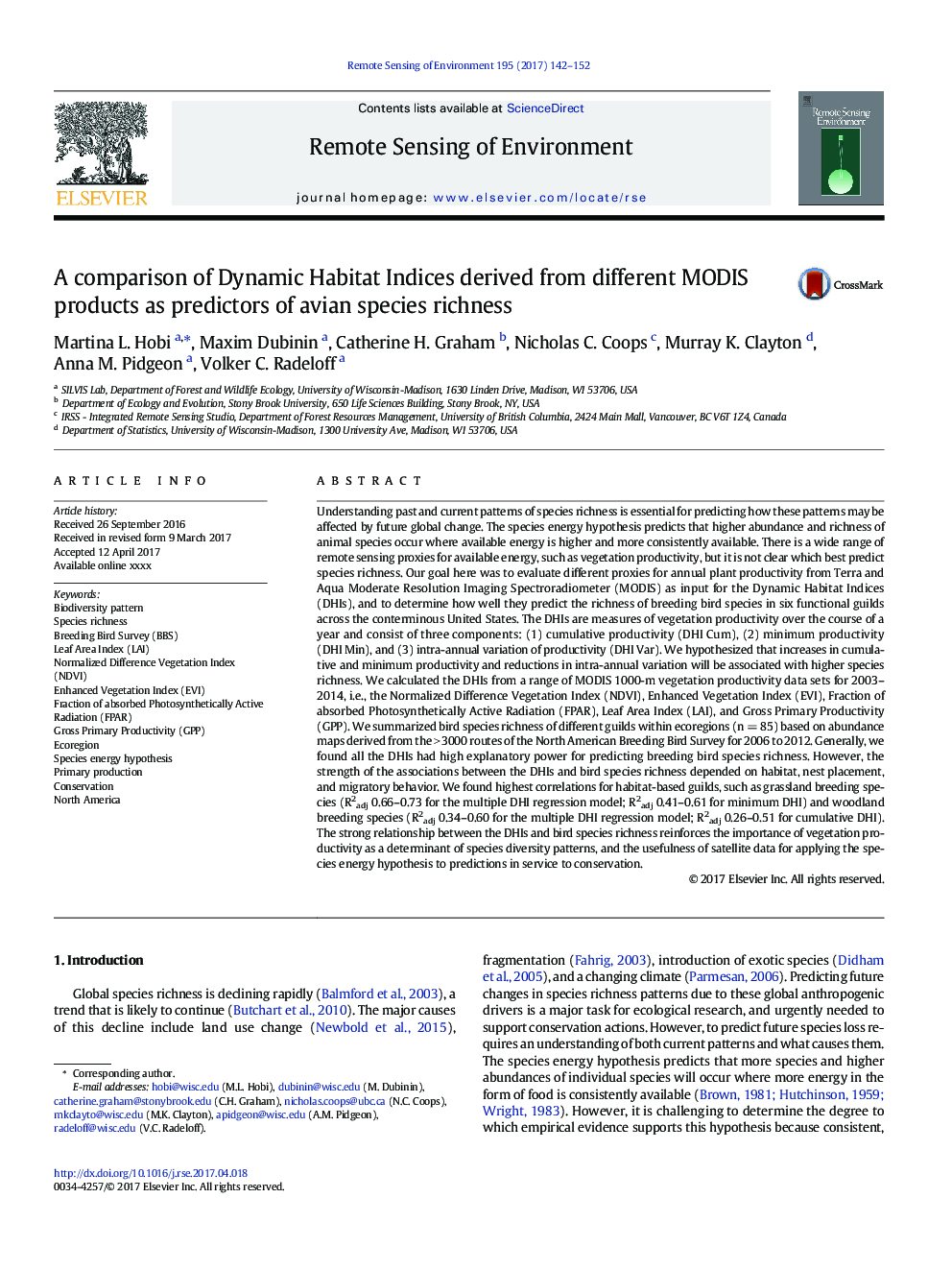| کد مقاله | کد نشریه | سال انتشار | مقاله انگلیسی | نسخه تمام متن |
|---|---|---|---|---|
| 5754812 | 1621205 | 2017 | 11 صفحه PDF | دانلود رایگان |
عنوان انگلیسی مقاله ISI
A comparison of Dynamic Habitat Indices derived from different MODIS products as predictors of avian species richness
دانلود مقاله + سفارش ترجمه
دانلود مقاله ISI انگلیسی
رایگان برای ایرانیان
کلمات کلیدی
Gross Primary Productivity (GPP)North America - آمریکای شمالیConservation - زیستشناسی بقاEnhanced vegetation index (EVI) - شاخص رشد گیاهی (EVI)Leaf area index (LAI) - شاخص سطح برگ (LAI)Normalized Difference Vegetation Index (NDVI) - شاخص عادی گیاه شناسی (NDVI)Species richness - غنای گونه ایPrimary production - محصول اولیهEcoregion - محیط زیست
موضوعات مرتبط
مهندسی و علوم پایه
علوم زمین و سیارات
کامپیوتر در علوم زمین
پیش نمایش صفحه اول مقاله

چکیده انگلیسی
Understanding past and current patterns of species richness is essential for predicting how these patterns may be affected by future global change. The species energy hypothesis predicts that higher abundance and richness of animal species occur where available energy is higher and more consistently available. There is a wide range of remote sensing proxies for available energy, such as vegetation productivity, but it is not clear which best predict species richness. Our goal here was to evaluate different proxies for annual plant productivity from Terra and Aqua Moderate Resolution Imaging Spectroradiometer (MODIS) as input for the Dynamic Habitat Indices (DHIs), and to determine how well they predict the richness of breeding bird species in six functional guilds across the conterminous United States. The DHIs are measures of vegetation productivity over the course of a year and consist of three components: (1) cumulative productivity (DHI Cum), (2) minimum productivity (DHI Min), and (3) intra-annual variation of productivity (DHI Var). We hypothesized that increases in cumulative and minimum productivity and reductions in intra-annual variation will be associated with higher species richness. We calculated the DHIs from a range of MODIS 1000-m vegetation productivity data sets for 2003-2014, i.e., the Normalized Difference Vegetation Index (NDVI), Enhanced Vegetation Index (EVI), Fraction of absorbed Photosynthetically Active Radiation (FPAR), Leaf Area Index (LAI), and Gross Primary Productivity (GPP). We summarized bird species richness of different guilds within ecoregions (n = 85) based on abundance maps derived from the > 3000 routes of the North American Breeding Bird Survey for 2006 to 2012. Generally, we found all the DHIs had high explanatory power for predicting breeding bird species richness. However, the strength of the associations between the DHIs and bird species richness depended on habitat, nest placement, and migratory behavior. We found highest correlations for habitat-based guilds, such as grassland breeding species (R2adj 0.66-0.73 for the multiple DHI regression model; R2adj 0.41-0.61 for minimum DHI) and woodland breeding species (R2adj 0.34-0.60 for the multiple DHI regression model; R2adj 0.26-0.51 for cumulative DHI). The strong relationship between the DHIs and bird species richness reinforces the importance of vegetation productivity as a determinant of species diversity patterns, and the usefulness of satellite data for applying the species energy hypothesis to predictions in service to conservation.
ناشر
Database: Elsevier - ScienceDirect (ساینس دایرکت)
Journal: Remote Sensing of Environment - Volume 195, 15 June 2017, Pages 142-152
Journal: Remote Sensing of Environment - Volume 195, 15 June 2017, Pages 142-152
نویسندگان
Martina L. Hobi, Maxim Dubinin, Catherine H. Graham, Nicholas C. Coops, Murray K. Clayton, Anna M. Pidgeon, Volker C. Radeloff,